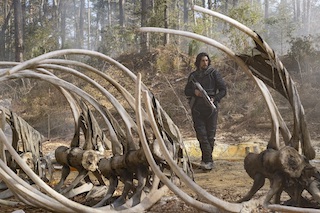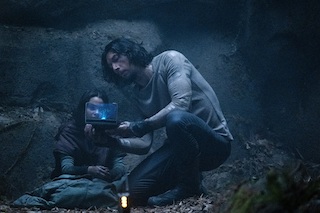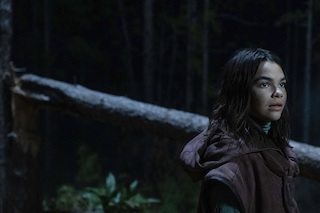 In the new sci-fi thriller 65, after a catastrophic crash on an unknown planet, pilot Mills (Adam Driver) quickly discovers he’s stranded on Earth 65 million years ago. Now, with only one chance at rescue, Mills and the only other survivor, Koa (Ariana Greenblatt), must make their way across an unknown terrain riddled with dangerous prehistoric creatures in an epic fight to survive. The film’s unique future-meets-past plot presented a myriad of daunting challenges as well as endless opportunities to produce inventive, engaging sound.
In the new sci-fi thriller 65, after a catastrophic crash on an unknown planet, pilot Mills (Adam Driver) quickly discovers he’s stranded on Earth 65 million years ago. Now, with only one chance at rescue, Mills and the only other survivor, Koa (Ariana Greenblatt), must make their way across an unknown terrain riddled with dangerous prehistoric creatures in an epic fight to survive. The film’s unique future-meets-past plot presented a myriad of daunting challenges as well as endless opportunities to produce inventive, engaging sound.
Directed by Scott Beck and Bryan Woods, the film tasked its award-winning sound team with supporting spacecraft and other futuristic technology, while also requiring them to travel back in time to conjure the thunderous soundscape of a vanished world populated by extraordinary and, in some cases, ravenous creatures.
“Scott and Bryan are wonderful filmmakers who love making movies and they encouraged us to do our best work in creating the world they imagined,” says supervising sound editor Steve Ticknor. “We had a talented crew, but this was a huge undertaking that pushed us to create sound that supported the story in a way that was both believable, and fresh, new and exciting.”
Initial sound work was done at Skywalker Sound by sound designer Mac Smith, whose relationship with Beck and Woods dates to an early film project nearly two decades ago. Smith began developing sound for 65 when it was still in its storyboard phase, and notes that this early work helped set the tone for the film. He points to a scene where Mills and Koa are sleeping outside a cave when a perimeter alarm sounds, warning of impending danger.
 “You think that they are about to be attacked by a dinosaur, but it turns out to be a leech in Koa’s mouth,” Smith explains. “You hear rain, thunder and the pulsing alarm as Mills removes the leech, but the alarm continues even after he gets it out. That’s when you realize, there is another danger after all, a much bigger threat.”
“You think that they are about to be attacked by a dinosaur, but it turns out to be a leech in Koa’s mouth,” Smith explains. “You hear rain, thunder and the pulsing alarm as Mills removes the leech, but the alarm continues even after he gets it out. That’s when you realize, there is another danger after all, a much bigger threat.”
Smith developed a palette of sounds to help bring the giant reptiles to life. “My first thought was to use non-animal sounds,” he recalls. “I experimented with rubber friction mallets on metal tubs, tubes and wood. I also went into the scoring stage at Skywalker to record these sounds for snorts and growls.” He followed a similar course to establish the character of the film’s futuristic technology.
“Mills has a large laser rifle that he uses to fight the dinosaurs,” he notes. “Scott and Bryan’s direction was to give the gun an intense blast, so the challenge was to capture that visceral feeling while adding a sci-fi tinge. Much of the technology has that same harsh texture, which says a lot about Mills’ home planet.”
Sound editorial and mixing continued at Sony Pictures in Culver City with sound designers Anthony Lamberti and Benjamin Cook collaborating with Ticknor in further developing the sounds of the dinosaurs and their lush, forbidding environment. “We knew immediately that it was going to be a journey of discovery,” says Lamberti. “Our job was to draw the audience into this strange world and make them feel the terror the characters feel. It was a steep hill to climb.”
As a starting point for creating guttural grunts, hisses and roars to match the behavior of various computer generated reptiles, Cook recorded his own vocalizations. “We often do that for our first pass to capture sounds that do what we need them to do,” he explains. “We then go back through and substitute elements that recreate the feel and emotional intensity. We also drew on a variety of other sources. For one of the babies, we used recordings of a bulldog puppy. For raptors, we employed cranes, parrots and crows. We manipulated all these sounds in different ways to give its creature a characteristic sound and personality.”
 One of Lamberti’s favorite scenes depicts the crash landing of Mills’ spacecraft after it’s been struck by a meteor. “It disintegrates as it falls over a cliff,” he notes. “A pair of T-rex appears and wreak havoc. The scene has loud crashes, cool T-rex sounds, bits of meteor falling from the sky, and Mills firing a weapon. It was pure mayhem—and a blast to work on. A sound designer’s dream.”
One of Lamberti’s favorite scenes depicts the crash landing of Mills’ spacecraft after it’s been struck by a meteor. “It disintegrates as it falls over a cliff,” he notes. “A pair of T-rex appears and wreak havoc. The scene has loud crashes, cool T-rex sounds, bits of meteor falling from the sky, and Mills firing a weapon. It was pure mayhem—and a blast to work on. A sound designer’s dream.”
While the battle with the T-rex was certainly memorable, the entire film demanded detailed, carefully crafted sound treatments. “It’s non-stop from the get-go,” says Cook. “Every reel has a signature scene. When Mills first crashes, he lands in a boggy swamp full of weird creatures. When he goes to higher ground to get his bearings, he encounters other dinosaurs. Each one needed to sound authentic. We had a lot of fun with the pterodactyls. We used geese honks that had a nice, hollow drone. We wanted each sound to have some basis in reality to make the audience believe that it’s real.”
The sound team worked just as hard to make future technology believable. “The spaceship’s computer system has a voice,” says Ticknor. “And we had many discussions about how that voice should sound. We brought in several actors, but none felt quite right. At the end of the day, we used a voice produced through artificial intelligence. It was remarkable. Perfect for the story.”
Lamberti notes that building the soundtrack required close collaboration with film’s sound and visual effects teams, and regular communication with Beck and Woods. “Everyone knew what we had to accomplish, and each person focused on the tasks they were assigned,” he observes. “We shared a common goal: to enhance the story and drive it forward.”
Ticknor says he was grateful to be working with a team that brought both passion and experience to the project. “It takes many committed artists,” he concludes. “It was a challenge to—in a very short time—create dinosaurs, spaceships, meteors and heart-pounding action, but they did it and molded it into a polished, entertaining soundtrack.”
Columbia Pictures’ 65 is now available on digital and on Blu-Ray on May 30.
